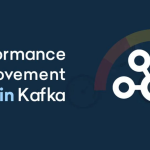Data engineers and architects who work on Kafka projects are often concerned about the risk of data corruption, misinterpretation, or data loss. This could lead to errors, delays, and other problems.
For example, if data is corrupted, it could lead to incorrect calculations or decisions. If data is misinterpreted, it could lead to incorrect insights or reports. And if data is lost, it could lead to a loss of business continuity.
As data complexity and volumes increase, Kafka’s ability to handle large scale data streaming becomes more crucial. However, Kafka alone cannot address all the challenges related to data that organizations encounter.
This is where Data Contract comes into play.
In this article, we will
- Explore the intricacies of the producer consumer architecture in Kafka
- How it seamlessly integrates with Schema Registry and Data Contract.
- How this combination overcomes obstacles associated with data.
- How it creates opportunities for an event driven ecosystem.
By embracing and adhering to the data contract, organizations can fully utilize Kafka’s capabilities while protecting against data and schema changes.
How Kafka works?
Kafka operates through a clever producer-consumer setup, where data flows continuously in response to events. Producers send out these events, essentially data messages, into specific Kafka topics.
Meanwhile, consumers are on standby to subscribe to these topics and process events in real-time. This architecture equips organizations to tap into data the moment it is generated, making swift and informed decisions while adapting promptly to evolving events.
However, what if a consumer receives invalid data? There should be an agreement in place which could protect from data quality issues or schema modifications. That’s when data contracts come into play.
Unveiling the Crucial Role of Data Contracts
A data contract acts as a guiding blueprint, dictating the structure, format, and ground rules governing the data being exchanged. This contract acts as a vigilant guardian, ensuring that data is accurately serialized, effectively communicated, and effortlessly grasped by all parties involved.
Without this contract, data communication could easily descend into chaos, leading to misinterpretation, errors, and a lack of consistency.

Navigating the Seas of Data Serialization with Avro Schema
The Avro schema takes center stage, laying out the data’s blueprint using a syntax reminiscent of JSON. This schema-centric approach ensures that data is consistently transformed into a format that can be understood across diverse systems, programming languages, and platforms.
By encapsulating the structure and data types within the schema, Avro plays a pivotal role in maintaining data consistency across the entire data pipeline.
Tackling the Challenges: Data Consistency and Evolution
Imagine a scenario where a multitude of components interact, exchanging vital data. As applications evolve, data structures inevitably follow suit. The crux of the challenge lies in maintaining data consistency while gracefully accommodating the fluid nature of schema evolution.
The goal is to safeguard data integrity throughout these dynamic transformations. Without a robust system in place, evolving schemas could lead to data mismatches, resulting in data loss or misinterpretation.
Kafka: The Cornerstone of Event-Driven Architecture
The producer-consumer model forms the bedrock of Kafka architecture. Producers emit events into Kafka’s various topics, while consumers eagerly subscribe to these topics, processing events in real-time. This dynamic setup facilitates a harmonious flow of data integration, enabling different elements of the system to seamlessly converse.
Kafka’s distributed and scalable nature ensures that events are reliably delivered, maintaining data consistency even in the face of high data loads.
The Strategic Role of the Confluent Schema Registry
Crucial to upholding the sanctity of data contracts is the Confluent Schema Registry. Imagine it as a vigilant sentry ensuring all entities converse in a unified data dialect. This centralized repository serves as the designated vault for storing and meticulously managing different iterations of Avro schemas, each associated with specific Kafka topics, known as subjects.
By providing a single source of truth for schema management, the Schema Registry ensures that all parties are on the same page, reducing the risk of incompatible schema versions causing data discrepancies.
The Enchantment of Compatibility Checks
But the Schema Registry doesn’t stop at schema storage—it offers a veritable game-changer: compatibility checks. These checks ensure that changes to schemas are introduced seamlessly, without disrupting existing consumers.
Backward and forward compatibility become the linchpin, allowing both older and newer consumers to interpret and interact with evolving schemas harmoniously. Without compatibility checks, a minor schema change could lead to a major breakdown in data communication.
Unravelling Data Woes: A Step-by-Step Odyssey
Avro Schema Unveiled: Our journey begins by unearthing the Avro schema, the guiding manuscript that dictates the data’s very essence. This schema, extracted from the Data Contract in a repository like GitHub, serves as the foundation for data serialization.
Joining Forces with the Schema Registry: The producer collaborates with the Schema Registry, fetching the freshest schema linked to the subject (Kafka topic). This schema becomes the beacon guiding the data’s transformation.
Data Validation: Prior to embarking on its Kafka voyage, the producer rigorously validates the data against the schema’s pre-established constraints, ensuring adherence to the revered data contract. This validation process checks for field existence, data types, and other rules defined in the schema.
Metamorphosis into Avro Format: The data shape-shifts into Avro format, utilizing the fetched schema. This metamorphosis ensures that the serialized data retains its integrity throughout the data pipeline. Avro’s built-in data serialization and deserialization mechanisms handle the heavy lifting seamlessly.
Extra Mile Validation: The producer doesn’t merely stop at the basics- it embarks on a journey of thorough validation, scrutinizing fields against stipulated patterns and data types defined in the schema, a hallmark of data quality assurance. This meticulous validation reduces the risk of incompatible data entering the system.
Dispatching Data to Kafka: Armed with validated and serialized data, the producer embarks on a journey to the Kafka realm, where the data eagerly awaits its turn to be consumed. Kafka’s fault-tolerant design ensures data consistency even in the face of network issues or node failures.
Versioning and Compatibility Guardians: By forging an unbreakable bond between the schema and a unique ID, the producer ensures that consumers eternally reference the apt schema version. Compatibility checks stand guard, shielding against disruptive schema shifts. This compatibility ensures that consumers, whether new or old, can process events without unexpected errors.

Putting the Validations to the Test
Now, let’s put the data validations we discussed earlier to the test. Imagine a scenario where the producer code attempts to send data that doesn’t adhere to the schema’s rules:
Test Case 1: Missing Required Field
Suppose the producer code tries to send data without the “key” field, which is marked as required in the schema. The validation process should catch this error and prevent the data from being sent to Kafka.

Test Case 2: Invalid Data Type
Let’s say the producer attempts to send data with the “kpartition” field as a string instead of an integer. The validation process should recognize this data type mismatch and reject the data.

Test Case 3: Invalid Timestamp Format
If the producer sends data with an incorrect timestamp format that doesn’t match the pattern specified in the schema, the validation process should detect this mismatch and halt the data transmission.

Test Case 4: Incompatible Key Pattern
Suppose the producer tries to send data with a “key” that doesn’t match the pattern defined in the schema. The validation process should identify the discrepancy and prevent the data from proceeding.

By subjecting the producer code to these test cases, we ensure that the data validation mechanisms effectively safeguard the integrity of the data contract, preventing erroneous or incompatible data from entering the Kafka ecosystem.
This proactive validation approach helps maintain data consistency and avoids potential downstream issues.
Way forward
In today’s data driven world it is crucial to establish a harmonious data ecosystem. This can be achieved by leveraging the power of Avro schemas embracing the event driven architecture of Kafka and utilizing the Schema Registry capabilities, in managing versions and ensuring compatibility. By doing this, organizations can bridge gaps between components, technologies, and teams.
Data contracts play a role in guiding data through its journey while maintaining its accuracy and reliability.






